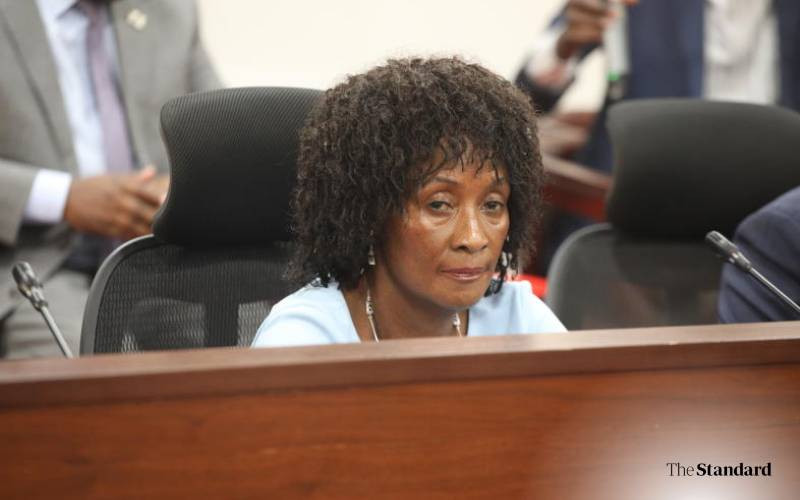The Teachers Service Commission (TSC) has three days to explain the circumstances under which 5,291 teachers who had not served for at least three years in their grades were promoted.
The National Assembly Committee on Education yesterday also accused TSC of disadvantaging some sections of the country in recent promotions after changing the rules, which saw some of the teachers who have been waiting for promotion, some for up to 18 years, miss out.
Commissioners, led by the Chief Executive Officer Nancy Macharia and chairperson Jamleck Muturi, were put to task to explain why some teachers were promoted before serving for the required period.
“When you look at these promotions, it looks like they were shared by commissioners. I come from a constituency where only 30 teachers were promoted and would like to know the population of teachers in the sub-county. What informs the promotion criteria?” said Igembe North MP Julius Manaiba.
The committee chairman, Julius Melly, said questioned some of the recent decisions by the TSC.
“All of us are in support that promotions are fairly done across the republic. That you would sit down as commissioners to disadvantage some regions against others this committee will never accept. We are giving you exactly seven days and we need not ask you for data,” said the Tinderet MP.
“The issues raised need to be addressed. We meet on Tuesday next week and we will require information three days before so that we can be able to interrogate it and that will be the last meeting before we go to the next course of action.”
The team is demanding a list of teachers promoted recently, including raw data for each sub-county “because it seems like areas where certain commissioners come from were favoured”, according to Lugari MP Nabii Nabwera.
“I cannot understand how some areas like Lamu West could promote 202 teachers and others with more than 4,000 teachers promote less than 60…even the number of schools in Lamu West is not a quarter of what I have.”
The bone of contention has been the recent promotion of 25,252 teachers, with the data presented to the committee showing that the highest slots were taken by the Kikuyu community at 4,668, followed by Kalenjin with 4,003, Luhya (3,148), Luo (2,388), Kisii (1,923) and Meru with 1,562.
Some of the sub-counties which got the highest number of promotions included Lamu West with 202, Samburu Central (185), Baringo Central (163), West Pokot (149), Tana Delta (143), Kirinyaga East (126), Mbeere North (128), Bureti (124) and Kirinyaga Central with 121.
Dr Macharia, however, explained that the commission analyzed its database to determine the adequacy of potential applicants who had completed the requisite three years in one grade.
“The findings revealed that the shortage of potential applicants affected both ASAL and non-ASAL counties. To ensure that promotions were distributed across the country and that no county was disadvantaged, the commission adopted a flexible approach,” she said.
The requirement that one must have served in one grade for three years was reduced to six months for teachers in counties that lacked adequate numbers of eligible candidates.
Stay informed. Subscribe to our newsletter
The commission argued that the flexibility, which considered staffing challenges such as teachers in acting positions and marginalised groups, was meant to ensure fairness in the distribution of opportunities.
“For example, in grade D3 (principal), the analysis showed that there were no adequate teachers in grade D2 who had served for the requisite three years. In this regard, a waiver was granted from three years to six months in all the 47 counties to attract applicants. In addition, for Deputy Principal III (D1) position, the commission waived the three-year requirement for 18 including Migori, Narok, Busia, Bomet, Homa Bay, Kwale and Mandera,” said Macharia.
“The commission’s decision was also informed by the need to minimize delocalisation of teachers, enabling them to serve within their localities where possible and to progressively promote administrators in acting capacities to substantive grades. As a result of the waiver a total of 5,291 teachers who had not served for at least three years in their grades were promoted.”
Macharia also explained that due to affirmative action, the exercise achieved a gender distribution of 47.04 per cent female and 52.96 per cent male, exceeding the one-third gender rule.
Similarly, she said 1,275 teachers with disabilities were promoted in 2024/2025.
Macharia said that the policy on appointment and deployment of institutional administrators requires that Principals be in D3, D4 and D5 grades, Deputy Principals be in D1, D2 and D3 grades. Head teachers be in C5 and D1 grades and Deputy Headteachers be in C4 and C5 grades.
She said the job evaluation conducted in 2016 reinforced this grade expectation to reflect the worth and complexity of the duties undertaken by these teachers.
An analysis of the current staffing situation in ASAL counties and other listed hard-to-staff areas reveals that institutional administrators are performing in lower grades that do not match the level of responsibility they carry.
“Majority of these teachers serve in grades C2, C3, C4 and C5 rather than the required D grades for principals and deputy principals. Head teachers and Deputy Head teachers are similarly under-graded, some serving in C1, C2 or C3 instead of the requisite grades. These teachers have been performing administrative duties for many years without substantive appointments,” she explained.



















